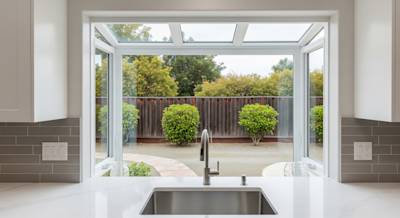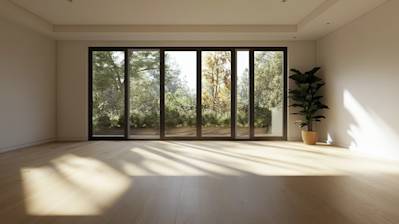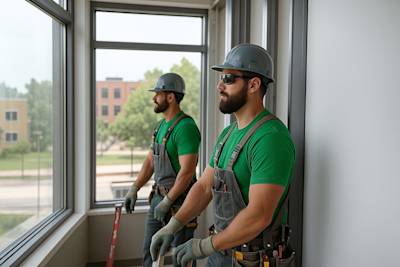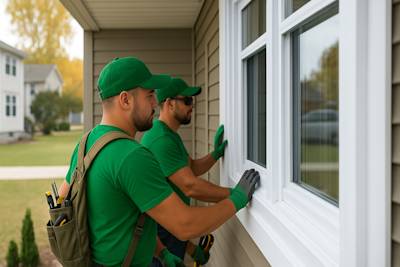Are you looking to seal your windows effectively? Do you want to cut down on your energy costs and keep your home warm during the winter and cool during the summer? Well, then you're in the right place. This comprehensive guide will walk you through the process of how to seal windows effectively, ensuring you have a cozy, efficient home in no time!
Importance of Sealing Your Windows
Windows are a crucial part of our homes. They let in natural light, offer great views, and contribute substantially to the overall aesthetic of our residences. However, over time, windows can develop cracks, gaps, and openings that allow drafts to come in and conditioned air to escape.
- Overlooked, unsealed windows can contribute significantly towards energy waste.
- Failures in window sealing can lead to discomfort during harsh weather conditions.
- By sealing your windows efficiently, you can save on energy costs and increase home comfort.
Hence, proper window sealing is invaluable. Ready for this straightforward DIY task? Let's get started.
Tools and Supplies Needed
Before proceeding, gather all the necessary supplies to ensure a smooth process:
- Weatherstripping
- Window insulation film
- Caulk and a caulk gun
- Silicone sealant
- Tape measure
- Scissors
- Utility knife
- Hairdryer
Remember, safety first. Use your utility knife with caution and handle all materials according to their respective safety instructions.
Step-by-step Guide to Seal your Windows
Here is a detailed step-by-step guide on how to effectively seal your windows.
Examining your Windows for Leaks
The first step is to inspect your windows thoroughly. Here's how:
- Run your hand around the window edges to detect any air leaking through.
- Look for potential gaps and cracks in the window frame and pane.
Installing Weatherstripping
Weatherstripping is an excellent tool for sealing windows, particularly for the movable parts.
- Measure your window and cut your weatherstripping to fit.
- Peel the adhesive backing from your weatherstripping, align it with the frame of the window, and press into place.
Using Window Insulation Film
Window insulation film adds an extra buffer against drafts and is transparent, enabling natural light to enter your home.
- Measure your window and cut your film, leaving an extra inch on all sides.
- Apply double-sided tape around the window frame.
- Attach the window insulation film to the double-sided tape and use a hairdryer to shrink it to fit, removing any wrinkles.
Applying Caulk
Caulk is ideal for sealing the non-moving parts of a window.
- Use a caulk gun to apply a thin, even bead of caulk to all joints and cracks.
- Use a caulk smoothing tool to ensure an even, clear seal.
Applying Silicone Sealant
Silicone is ideal for sealing any gaps between your window frame and your home's siding.
- Apply the sealant along the gaps, ensuring you fill them completely.
- Smooth the sealant with a spreader tool for a clean finish.
Maintaining a Window Seal
After all the efforts of weatherstripping, using insulation film, caulk, and silicone, maintenance is crucial to ensure lasting results:
- Regularly check your window seals, especially before the change of season.
- Gently clean the sealed areas during your regular window cleaning sessions.
- Reapply weatherstripping, caulk, or silicone as needed over the years.

Frequently Asked Questions about How To Seal Windows
What signs should indicate that I need to seal my windows?
If you're noticing a draft, even when your windows are closed, this is a clear indicator that your windows might need sealing. Another sign can be a significant increase in your energy bills. Also, if you can see daylight around your window frames, this means that your windows definitely need to be sealed.
Can I seal windows by myself, or do I need a professional?
It depends on your comfort level with DIY projects. Sealing windows is not overly complicated and with the right tools and materials, most people can complete this task on their own. However, if you're uncomfortable doing this work yourself or your windows are in hard-to-reach areas, it may be a good idea to hire a professional.
What materials do I need to seal windows?
To seal your windows, you'll need weatherstripping material or caulk, a caulk gun, a utility knife, and cleaning supplies. Weatherstripping comes in various types, including V-strip, adhesive-backed tape, and door sweeps. For areas where the window sash meets the frame, you will use weatherstripping. For the parts of the window that do not move, use caulk.
What is the process for sealing windows?
First, you will need to thoroughly clean the area around your windows. Once dry, you can then apply the weatherstripping to all movable parts. For the non-moving parts, apply the caulk using the caulk gun, making sure to create a seal all the way around. Let the caulk dry for the recommended time before testing your window.
When is the best time of the year to seal windows?
The best time to seal your windows is during a dry and warmer season, such as late spring, summer, or early fall. The reason being, most caulk requires dry conditions to properly set and adhere to the surfaces. Moreover, who would want to work on a cold, snowy day?
How often should window seals be replaced?
How often you should replace your window seals generally depends on the quality of the material used, but on average, it's suggested to check them once a year for any signs of wear and tear. If you're noticing a draft or your energy bills are creeping up, it might be time to replace the seals.
Is sealing windows a cost-effective solution?
Yes, sealing your windows can be a cost-effective solution, particularly when you consider the reduction in heating and cooling costs. The materials needed for window sealing are relatively inexpensive, and the process can be completed in a single day.

Pros of Sealing Windows
Enhanced Energy Efficiency
Lower Energy Bills
Window sealing effectively reduces the gaps and spaces that allow heat exchange with the outside environment. This translates to less heat loss during winters and reduced heat gain in summers, leading to lower energy use and ultimately lower energy bills. Particularly, in areas with extreme weather conditions, this advantage can represent substantial savings on energy consumption throughout the year.
Less Pressure on HVAC Systems
When windows are properly sealed, the heating, ventilation, and air conditioning (HVAC) units won't have to overwork to maintain the desired home temperature. This results in fewer breakdowns, less maintenance, and a longer lifespan for the HVAC systems.
Comfortable Living Environment
More Consistent Indoor Temperatures
By sealing windows, temperature fluctuations in different parts of the house can be drastically reduced. This results in a homely environment where each room and corner of the house feels more comfortable and inviting.
Reduced Noise Pollution
Sealed windows are effective at reducing outside noise and keep the home environment quiet and peaceful. This is particularly beneficial for homes in busy urban areas or near sources of noise such as highways or construction sites.
Environmentally Responsible
Lower Carbon Footprint
By reducing the need for constant climate control, sealing windows helps to lower your household's carbon footprint. This is a practical step that every homeowner can take to contribute to the reduction of global greenhouse gas emissions.
Cons of Sealing Windows
Cost and Time
Immediate Expense
The cost required to seal your windows properly can be quite significant, especially when hiring professionals and using high-quality materials. While there are cheaper DIY options, they may not always provide the same levels of efficiency and durability.
Time-Consuming
It can take a substantial amount of time to seal all the windows in your home, especially if you are doing it yourself. Professionals can work faster but may still require multiple visits to complete the job, depending on the number and condition of your windows.
Reduced Ventilation
Potential for Trapped Moisture
Fully sealing windows can lead to insufficient ventilation, which in turn can trap moisture inside the house. This can lead to problems such as condensation or even mold growth, especially in damp rooms like bathrooms and kitchens.
Risk of Indoor Pollutants
Without proper ventilation, indoor pollutants (from products like cleaning supplies, candles, and tobacco) can accumulate inside the home, leading to potential health problems.
Possible Damage to Window Frames
Poorly executed sealing jobs or use of inappropriate sealing materials can cause damage to window frames. Over time, such damage can lead to a need for more extensive and expensive repairs.
Potential Affects on Aesthetics
Sealing materials can sometimes be visible, and depending on the method used, can slightly alter the overall look of your windows. This could potentially affect the aesthetic appeal of your home, especially if the sealing is not done uniformly across all windows.
Limited Effectiveness in Some Cases
In homes with old, poorly insulated windows, sealing alone might not be enough to significantly improve the energy efficiency. In such cases, full best window replacement in Sacramento might be a more effective, albeit more expensive, solution.

Myths/Misconceptions about Sealing Windows
Sealing windows is an essential home maintenance task, but various misconceptions often cloud its necessity, techniques, and benefits. Here, we debunk common misconceptions and offer factual information about sealing windows.
Myth 1: Only Old Windows Need Sealing
Undeniably, old windows are more prone to drafts due to wear and tear over time. However, that doesn't mean new windows don't require sealing. A common misconception is that if the windows are new, they don't need to be sealed. Even newly installed windows may need additional sealing. During the installation process, there may be minor gaps that are overlooked, leading to air leaks, compromising the energy efficiency of your home. Therefore, regardless of the age or condition of windows, a regular check and necessary sealing are essential.
Myth 2: Sealing Windows in Warmer Months is Pointless
Many homeowners believe that sealing windows is only beneficial during the colder months to prevent drafts. However, window sealing is not just about keeping cold air out; it's also about keeping cool air in. During warmer months, windows that aren't sealed properly can cause your air conditioning to work overtime, leaching out cool air and hiking up your energy bills. It's beneficial to seal windows in warm seasons to optimize indoor thermal comfort and energy efficiency.
Myth 3: DIY Sealing is as Good as Professional Sealing
While there are plenty of DIY guides on window sealing, it doesn't necessarily mean they yield the same results as professional work. The misunderstanding here is that window sealing is a simple task. Although DIY approaches work fine for quick fixes, they may not provide a long-term solution. Professionals have the proper tools and experience to identify all leak points, choosing the right sealing materials to ensure a complete and long-lasting seal.
Myth 4: All Window Seals Are the Same
There's a common misconception that all window seals are identical and will provide the same amount of efficiency. However, the reality is that various types of window seals exist, each offering different levels of insulation. For example, V-strip (or tension seal) is a durable plastic or metal strip folded into a 'V' shape that springs open to bridge gaps. Adhesive-backed foam tape is another choice which is easy to install but may not be as durable. The type to be chosen depends on the window type, gap size, and exposure to moisture and temperature changes.
Myth 5: Sealing Windows Fully Stops Condensation
Many believe that if their windows are sealed appropriately, it will completely stop condensation. While a substantial amount of condensation can indeed be reduced by quality sealing, it may not entirely prevent it. Condensation is a result of excessive moisture in the house and temperature differences between the inside and outside. Other ways to control condensation include increasing ventilation, using a dehumidifier, or insulating your home better.
Myth 6: Sealing Windows Makes the House Air Tight
Properly sealing your windows can improve energy efficiency and reduce drafts, but your home still has various places where air can escape such as doors, chimneys, basements, vents etc. Hence, a common fallacy is that sealing windows alone can achieve a completely airtight house. A fully airtight home would lack ventilation, which is necessary for maintaining indoor air quality. That's why it's important to balance sealing measures with adequate ventilation.
Myth 7: Only Expensive Sealing Materials Provide Desired Results
It's a common myth that only expensive sealing materials can ensure proper insulation and longevity. Quality window sealing doesn't always mean the most expensive products should be used. Even affordable options like weatherstripping or caulk can protect your windows against drafts and energy loss effectively when done accurately. However, for bigger gaps or longer-term solutions, investing in higher-quality materials may be necessary.
By debunking these myths and misconceptions, homeowners can make informed decisions about sealing their windows, ensuring more efficient energy usage, improved comfort levels, and potential savings on utility bills.
Summary
Sealing your windows can provide a range of benefits. From cutting down on energy costs, maintaining temperature fluctuations to preventing dust and bugs from getting in. The technique for how to seal windows isn't too complex and can be a DIY project for most homeowners. Remember, though, each window type might need a slightly different sealing approach, but with a little research, you can be up to the job.
So, now that we've gone through the process of how to seal windows, it's clear that it is a task that requires patience and precision. The key is to prepare well in advance, have all your materials and tools ready, and proceed with a calm mind. Whether it's caulking, weatherstripping, or using a window film, successful sealing can significantly enhance your home's comfort and efficiency.
Finally, it's essential to review the sealing after a few days and not just immediately after you finished the process. Giving it some time allows the materials to settle down properly. With the know-how of sealing windows, regular inspection, and periodic maintenance will ensure that the seal remains intact and the windows function well over the years. Make this a part of your home care routine for a cozy and energy-efficient home.
About GVD Renovations & Remodeling
At GVD Renovations & Remodeling of Roseville, CA, we're more than just a remodeling firm, we're a group of passionate professionals who take immense pride in transforming your vision into reality. Being in business for several decades, we have honed our skills in home renovations, exterior remodeling, and window installation projects giving your home a fresh, stylish, and functional look. Our team, based in the heart of Roseville, continuously strives for excellence and customer satisfaction, ensuring every detail aligns with your aesthetic preferences and lifestyle needs. Our motto? Transforming homes, exceeding expectations!
This article is for general information only and not professional advice. Always consult a licensed contractor before making project decisions. Product details, specifications, or warranties may have changed since publication. Brand and product mentions reflect opinion, not endorsements or guarantees.
Tags: DIY, weatherproofing, home improvement,



















